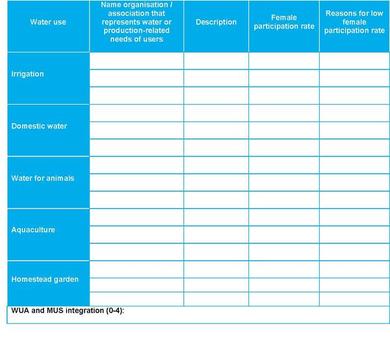Tool 6
TOOL 6. IDENTIFICATION OF USER REPRESENTATION
To collect information on whom (individuals or organisations) represents the different users and the extent to which users and uses are represented in (formal) water management bodies.
OBJECTIVE
To collect information on whom (individuals or organisations) represents the different users and the extent to which users and uses are represented in (formal) water management bodies.
METHOD
Key informant interviews with service providers and representatives of different user groups.
Step 1: Introduction
Introduce the exercise to the key informant and draw a matrix on a flipchart with the different uses in the left hand column. See example in Table 8.
Table 8 - User representation

Source: Wiegers and Waha, n.d.
Step 2: List organisations or associations in the second column
For each water use service, ask key informants to list the organisations or associations that represent the water and/or production-related needs and interest of its users. Briefly describe the different organisations that represent the different users in the third column (for instance mandate, membership, level of influence, etc.).
Step 3: Female participation
For each user organisation or association, ask key informants for the participation rate of female users. Include reasons for low female participation where required.
Step 4: Water User Associations (WUA) and MUS integration
In case of irrigation-plus as the entry point, ask key informants to identify to what extent users and uses other than irrigation are represented in WUAs by using a scale of 0 – 4.
0 = WUAs concentrate on irrigation and ignore or deny other users and water use services.
1 = WUAs are aware of MUS related practices but do not consider them as part of their mandate.
2 = WUAs are aware of MUS services and consider needs and interests of some (related) practices.
3 = WUAs incorporate the concerns of other services/users.
4 = WUAs are fully integrated and comprise multiple users directly (for instance domestic uses have a voice in the WUA) or indirectly via the municipality.
Step 5: Areas for further investigation
Based on discussions with key informant interviews, identify areas that require further investigation and reasons for this.
BASED ON
Tool 4 in: Wiegers, E., and Wahaj R., forthcoming. Multiple Uses of Water Services for Men and Women in Large Irrigation Systems: Engendering the MASSMUS approach, MASSMUS Gender Module, Rome: Food and Agriculture Organization of the United Nations.
